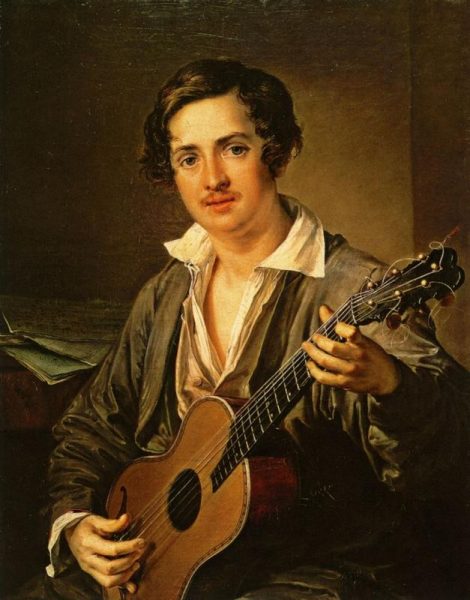…and welcome to my 7-string Guitar in DGBdgbd’ tuning site!

Here you will find information about the instrument, its composers, contemporary players, recordings, videos, etc, and also my own explorations as I delve into the repertoire for the first time.
If you have any questions, just use the Contact page for private contact.
I welcome contributions in the form of essays – use the Contact page for initial contact, including your email address.
There are many thousands of 19th-century Russian and Ukrainian scores for the 7-string guitar, a repertoire which has largely been ignored, and is ripe for exploration. And there is no reason why new music should not be written or arranged for the instrument and its tuning.
The tuning is an open G major chord, from bass to treble: DGBdgbd’ – although this might seem unusual at first, strings are readily available, and the tuning is fairly easy to learn. Many original instruction methods survive, and although written in Russian, there is relatively little text, but a LOT of music.
Do explore the site – there are many treasures here! Although I run this site myself, I do so on behalf of the community. Any suggestions – use the CONTACT page.
Rob MacKillop
Edinburgh
Hello, Rob. It is a pleasure accompanying you in this new adventure of yours (ours).
I’ve already tuned my 7-string and it has been fun to trick my neurons and fingers. It’s the same instrument and a different one at the same time.
Thank you all your inspiring work!
Cheers,
Rui Namora
LikeLike
Hey, Rui, nice to hear from you. Great to see you are on the same journey. Keep us posted on your progress!
Rob
LikeLike
Wonderful. Coming at this from Brazilian choro. Very different use of 7-string guitar.
LikeLike
Indeed it is, Steve. I like both, but will leave the Brazilian stuff for later…
LikeLike
Hi Rob,
I also arrived here because of brazilian choro on 7-string guitar (there are 2 kinds: steel and nylon stringed – my preference is for nylon). If you intend to talk about brazilian 7-string guitar playing some time in the future, then I am most definitely going to stay tuned in 🙂
A little while ago I bought an old russian 7-string guitar (1940-ish, built in St Petersburg) that was ‘perfect for restoration’, which turned out to mean everything was cracked and broken because it was manhandled and strung with steel strings, though designed for nylon. When/if I succeed in turning it into a playable instrument again, I’ll certainly try Markov’s method. There are already some parallels to choro I see, like playing baixarias and/or melodies across the strings using open strings, in order to move quickly up and down the neck and so increase the available range, e.g. for a 16th note run.
cheers,
Jack
LikeLike
Cheers, Jack. The whole Brasilian 7-string thing has passed me by. I need at least five more lifetimes for all the music I want to explore!
LikeLike
I’d never heard of this instrument before but came here via a YouTube site that showcases the music played on the Russian guitar. I was expecting to hear something akin to the balalaika (six-stringed version) but not in the least. Thanks for setting up an interesting site.
LikeLike
Cheers, Marco. Hopefully there will be more to add to the site soon. Rob
LikeLike
Hello, Thank you for everything you’ve put here on this site. The Sychra Journal you have listed here has been a great source of material to get me into Russian guitar because I had no idea where to start when I was looking through the Russian database of thousands of pieces (and I don’t read Russian). Would you mind if I link to your page from my own blog?
LikeLike
Yes, go ahead. And thanks for asking. I’ll find your blog. Cheers…Rob
LikeLike